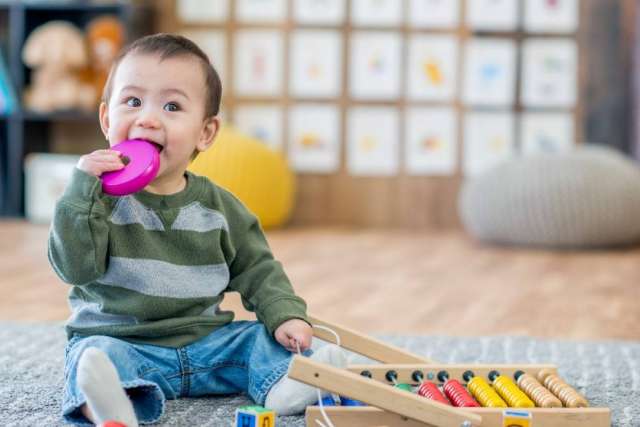Lead poisoning in children may feel like a problem of the past – children’s lead levels have dropped substantially since the 1970s. But a recent study of more than 1 million children younger than 6 found more than half the participants had detectable levels of lead in their blood. Scientific evidence shows that even small amounts of lead can affect a child’s intellectual development.
In response to these findings and the recommendation of its Lead Exposure Prevention and Advisory Committee, the Centers for Disease Control and Prevention (CDC) changed lead testing guidelines. The new standard recognizes lead poisoning at a lower blood lead level.
What does this mean for parents?
First, it will likely double the number of children between age 1 and 5 who are considered to have high blood levels. More importantly, the new standard means that children will get the treatment they need for lead exposure before more permanent damage is done.
Here’s what you should know:
What is lead poisoning?
Lead is a natural element found in the Earth’s crust. When animals and humans ingest too much lead, it can be toxic.
Lead enters our environment naturally through water, soil and air. But it’s also been used in a variety of products such as pipes, paint, ceramics and gasoline. People unknowingly expose themselves to lead when they touch, swallow or breathe in lead or lead dust.
Physicians use a blood test to measure an individual’s lead exposure. They measure micrograms of lead per deciliter of blood (mg/dL). In children, a blood lead level of 3.5 mg/dL or more indicates lead poisoning, according to the new CDC standard.
Lead poisoning in children
Lead exposure does not affect kids the same way it does adults. Children absorb four to five times more lead than an adult exposed to the same source.
Children younger than 6 are at the highest risk for long-term and permanent harm from lead poisoning. These young children are in the early stages of development and most likely to put their hands and other items in their mouths – increasing their chances of ingesting lead.
Health effects of lead exposure on kids
There is no safe blood lead level for children. Though it takes repeated exposure to high levels of lead for lead poisoning to occur, elevated blood lead levels affect almost every system and organ in the body.
According to the CDC, lead exposure in children can cause:
- Damage to the brain and nervous system
- Hearing and speech problems
- Issues with learning and behavior
- Slowed growth and development
Common sources of lead exposure for children
The most common ways kids come into contact with lead include:
- Lead-based paint: Homes built before 1978 were likely painted with lead-based paint, which can chip, peel or flake and may release contaminated dust when sanded or scraped.
- Contaminated soil: Dirt found in yards and playgrounds may contain lead from deteriorating buildings or equipment, leaded gasoline, leaks from underground tanks or industrial smoke.
- Children’s toys and jewelry: Some toys and play jewelry may contain lead, especially painted antique toys made of metal.
- Drinking water: Homes built before 1986 may have lead pipes and fixtures. As plumbing materials corrode or decay, lead can enter the water.
- Parents bringing lead into the house: Parents may unknowingly bring home lead if they are exposed at work (such as home renovation or working on cars) or through certain hobbies (including hunting or making pottery).
- Foreign-made food, cosmetics and medicines: Lead may be found in certain traditional or folk medicine and herbal remedies, as well as some food and cosmetics imported from foreign countries.
Tips for protecting your child from lead exposure
To keep your children safe from the effects of lead, wash their hands, toys and pacifiers often. If you are regularly exposed to lead at work, be sure to remove your shoes and clothing upon entering the house and wash them separately.
If you live in a house built before 1980, inspect and maintain all painted surfaces, wiping up dust often. Keep your child away from peeling paint until you can have your home checked for potential lead sources. For home renovation, choose contractors who are lead-safe certified by the U.S. Environmental Protection Agency (EPA).
If you suspect lead exposure
Not all children with lead poisoning will have symptoms, especially not right away. Since the symptoms develop slowly – and can be caused by other conditions — it’s easy to overlook lead poisoning. If symptoms do develop, they may include:
- Anemia (low blood cell count)
- Confusion
- Hair loss
- Headaches
- Muscle weakness
- Seizures
- Stomach pain and/or vomiting
If you live in an older home or worry that your child has been exposed to lead, your child’s physician can perform a blood test. If testing shows an elevated blood lead level, you’ll be connected with resources to help identify and remove lead from your child’s environment.
For very high blood lead levels, your child may undergo additional testing. Your doctor may recommend treatment with chelation therapy to remove lead from the blood. This medication, given orally or by injection, binds with the lead and the body excretes it in urine. Other follow-up care may include dietary changes, early educational services and further testing.
If you suspect your child has been exposed to lead or want to get your child tested for elevated lead levels, reach out to your child’s pediatrician.



